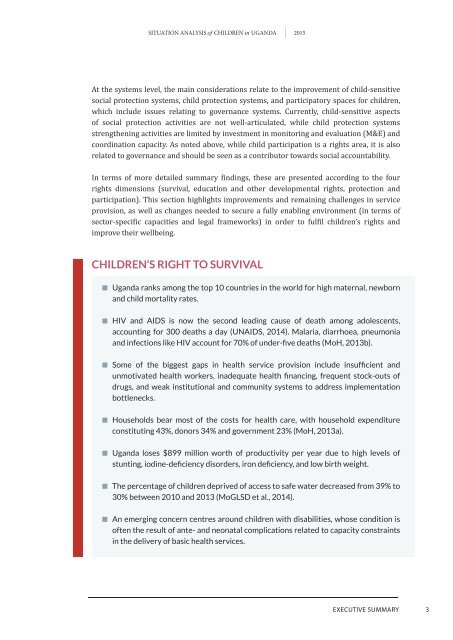Situation analySiS
1TNu802
1TNu802
Create successful ePaper yourself
Turn your PDF publications into a flip-book with our unique Google optimized e-Paper software.
<strong>Situation</strong> <strong>analySiS</strong> of Children in uganda 2015At the systems level, the main considerations relate to the improvement of child-sensitivesocial protection systems, child protection systems, and participatory spaces for children,which include issues relating to governance systems. Currently, child-sensitive aspectsof social protection activities are not well-articulated, while child protection systemsstrengthening activities are limited by investment in monitoring and evaluation (M&E) andcoordination capacity. As noted above, while child participation is a rights area, it is alsorelated to governance and should be seen as a contributor towards social accountability.In terms of more detailed summary findings, these are presented according to the fourrights dimensions (survival, education and other developmental rights, protection andparticipation). This section highlights improvements and remaining challenges in serviceprovision, as well as changes needed to secure a fully enabling environment (in terms ofsector-specific capacities and legal frameworks) in order to fulfil children’s rights andimprove their wellbeing.CHILDREN’S RIGHT TO SURVIVALuganda ranks among the top 10 countries in the world for high maternal, newbornand child mortality rates.hiv and Aids is now the second leading cause of death among adolescents,accounting for 300 deaths a day (unAids, 2014). malaria, diarrhoea, pneumoniaand infections like HIV account for 70% of under-five deaths (MoH, 2013b).Some of the biggest gaps in health service provision include insufficient andunmotivated health workers, inadequate health financing, frequent stock-outs ofdrugs, and weak institutional and community systems to address implementationbottlenecks.households bear most of the costs for health care, with household expenditureconstituting 43%, donors 34% and government 23% (moh, 2013a).uganda loses $899 million worth of productivity per year due to high levels ofstunting, iodine-deficiency disorders, iron deficiency, and low birth weight.the percentage of children deprived of access to safe water decreased from 39% to30% between 2010 and 2013 (moGlsd et al., 2014).An emerging concern centres around children with disabilities, whose condition isoften the result of ante- and neonatal complications related to capacity constraintsin the delivery of basic health services.ExECUtIvE SUMMary3




